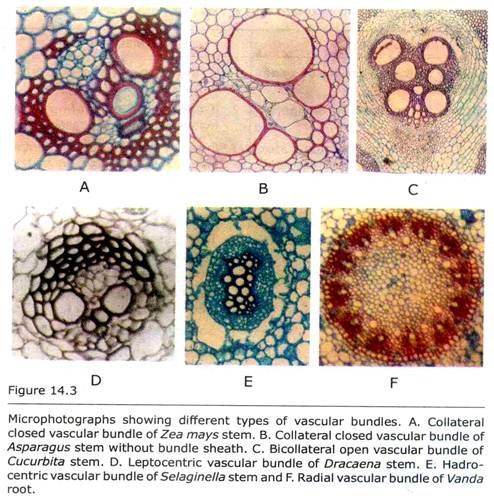ADVERTISEMENTS:
The following points highlight the four main types of vascular bundle. The types are: 1. Collateral Bundle 2. Bicollateral Bundle 3. Concentric Bundle 4. Radial Vascular Bundle.
Type # 1. Collateral Bundle:
A vascular bundle in which a strand c f phloem is present external to the strand of xylem on the same radius side by side is known as collateral bundle.
ADVERTISEMENTS:
Cambium may be present or absent in between xylem and phloem, and so there are the following two types of collateral bundle:
(a) Closed collateral bundle:
In this type cambium is absent in between xylem and phloem. Therefore stems having this type of bundle do not have normal secondary growth. Ex. Monocotyledonous stem. Usually these bundles are enclosed within bundle sheath made up of sclerenchyma and those that lack the sheath are considered as anomalous (e.g. Asparagus stem).
ADVERTISEMENTS:
(b) Open collateral bundle:
An open collateral vascular bundle has cambium called fascicular cambium between xylem and phloem. The bundles can increase in diameter by normal secondary growth with the help of fascicular cambium. Ex. Dicotyledonous stem.
Type # 2. Bicollateral Bundle:
A vascular bundle with phloem situated on the peripheral and inner side of xylem is known as bicollateral bundle. A strip of cambium termed outer cambium is present between the peripheral phloem and xylem; another strip of cambium, termed inner cambium, is also present between inner phloem and xylem.
The peripheral or external phloem is termed as outer phloem whereas the inner or internal phloem is called inner phloem. The sequence of vascular tissues in the bicollateral bundles from periphery toward centre is outer phloem, outer cambium, xylem, inner cambium and inner phloem.
These bundles are open type as strips of cambia are present but the secondary thickening occurs only by the outer cambium, i.e. cambium present between the outer phloem and xylem. Ex. Cucurbita stem.
Type # 3. Concentric Bundle:
A vascular bundle in which one type of vascular tissue surrounds the other is known as concentric bundle.
In this bundle xylem either encircles or is encircled by phloem and accordingly the following two types are recognized:
(a) Amphivasal bundle:
A vascular bundle in which xylem encircles the central strand of phloem is known as amphivasal bundle, also called leptocentric bundle. Ex. Dracaena, Yucca.
ADVERTISEMENTS:
(b) Amphicribral bundle:
A vascular bundle in which phloem encircles the central strand of xylem is called as amphicribral bundle, also known as hadrocentric bundle. Ex. Selaginella.
The concentric bundles, either amphivasal or amphicribral, are closed as there is no cambium in between xylem and phloem.
Type # 4. Radial Vascular Bundle:
A vascular bundle, in which the primary xylem and primary phloem strands are separated from each other by nonvascular tissues and they are situated on alternate radii of an axis, is known as radial vascular bundle or radial bundle.
ADVERTISEMENTS:
These bundles are the characteristic of roots. There is no primary cambium in this bundle and the secondary thickening occurs by the secondary cambium that originates at the time of secondary growth in dicotyledonous root only.
The dicot roots usually have four to six number of protoxylem poles in contrast to monocot root where many poles of xylem (more than six) are present. The number of protoxylem poles in a root may be 1, 2, 3, 4, 5, 6 or more. Accordingly they are called monarch, diarch, triarch, tetrarch and so on. The term polyarch is used when the number of protoxylem poles are more than six (Fig. 14.4).




